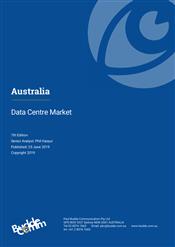Australia - Data Centre Market

Last updated: 3 Jul 2019 Update History
Report Status: Current
Report Pages: 135
Analyst: Sebastien De Rosbo
Australia leads the South East Asian data centre market
Australia has progressed to now be one of the four major sub-markets for data centres in Asia alongside Singapore, Hong Kong and Japan.
As data centres become larger and more efficient, new data centres are generally being built in centralised areas, mainly in the larger cities of Sydney and Melbourne, in order to achieve the required economies of scale. Both cities have developed to become regional hubs for large enterprises across a range of industries.
Data centre customers are migrating from co-location services and managed hosting to cloud services. Cloud providers are the fastest growing segment of most Australian data centre providers. There is a growing demand from corporate and government organisations looking to move their systems to the cloud with a private or hybrid cloud architecture. This is placing significant pressure on data centre providers that focus on co-location, especially for wholesale data centre providers.
The presence of different types of enterprises across a wide range of industries is attracting both local and international cloud providers to carrier neutral exchanges. The diversity and number of local and international cloud providers entering Australian data centres has significantly increased over the last five to seven years.
The growing presence of international cloud providers has also been particularly strong over the last three years. A growing trend is for these large public cloud providers to lease large amounts of floor space from specialist data centre providers located in Australia and operate their own data centres within these facilities.
A large amount of data centre capacity has been added over the last one or two years in Australia. This has led to lower than average occupancy rates in the short-term and is placing downward pressure on pricing.
Strong local demand has seen significant investment in new builds from both local data centre specialist providers such as NEXTDC and Canberra Data Centres (CDC) and global data specialist providers such as Equinix. These operators have significantly expanded their local presence significantly over the last couple of years. New providers such as Airtrunk and Data Exchange Network are also entering the local market. This trend is expected to continue over the next year as more data capacity will enter the market, from new and existing providers.
Strong growth is predicted to continue over the next five years to 2024.
The top category of data centre providers in Australia are data centre specialist providers, which indicates the level of maturity in the Australian market. As the Australian data centre market has matured, IT Service Providers and telcos, have been retreating from the market.
Recent growth in South East Asia has been driven by the international expansion of mainland Chinese players and cloud service providers in Asia, and strong migration to outsourced data centres by enterprises pursuing a hybrid cloud strategy. Australia is the leading adopter of hybrid and provide cloud solutions across South East Asia. Other advanced countries such as Singapore and Hong Kong are now following in their path.
Key developments:
- Large amount of data centre capacity has been added over the last one or two years in Australia.
- New builds from local and global data centre specialist providers.
- Emergence of Melbourne as a second key Australian data centre hub.
- AirTrunk opens a hyperscale data centre in Western Sydney.
- Strong growth is predicted to continue over the next five years to 2024.
Companied covered in this report include:
AirTrunk, Australia Data Centres, ALC, Australia Pacific Data Centres, Canberra Data Centre (CDC), Colt, Data Exchange Network, DXC Technology (HP), Digital Realty, Datacom, Equinix, Freshworks, FrontierDC, Fujitsu, Geraldton Data Centre, Global Switch, IBM, Interactive, iSeek, Macquarie Telecom, Micron21, NEXTDC, North Queensland Regional Data Centre, OnQ Communications, Optus, Polaris Data Centre, Pulse Data Centre, Telstra, Verizon, Virtutel, Vocus, YourDC
Phil Harpur
June 2019
Related Reports
- Australia - Telecoms, Mobile and Broadband - Statistics and Analyses
- South Pacific Islands - Telecoms, Mobile and Broadband - Statistics and Analyses
- Samoa - Telecoms, Mobile and Broadband - Statistics and Analyses
- Papua New Guinea - Telecoms, Mobile and Broadband - Statistics and Analyses
- New Zealand - Telecoms, Mobile and Broadband - Statistics and Analyses
- French Polynesia - Telecoms, Mobile and Broadband - Statistics and Analyses
- New Caledonia - Telecoms, Mobile and Broadband - Statistics and Analyses
- Vanuatu - Telecoms, Mobile and Broadband - Statistics and Analyses
Share this Report
TMT Intelligence
A platform to scale your intelligence tasks
Monitor critical insights with our AI-powered Market Intelligence Platform gathering and analyzing intelligence in real time. With AI trained to spot emerging trends and detect new strategic opportunities, our clients use TMT Intelligence to accelerate their growth.
If you want to know more about it, please see:
Research Methodology
BuddeComm's strategic business reports contain a combination of both primary and secondary research statistics, analyses written by our senior analysts supported by a network of experts, industry contacts and researchers from around the world as well as our own scenario forecasts.
For more details, please see:
More than 4,000 customers from 140 countries utilise BuddeComm Research
Are you interested in BuddeComm's Custom Research Service?
Hot Topics
News & Views
Have the latest telecommunications industry news delivered to your inbox by subscribing to BuddeComm's weekly newsletter.